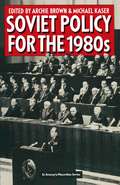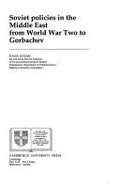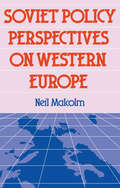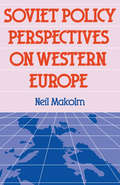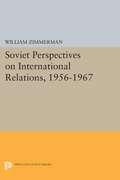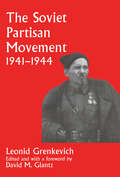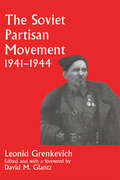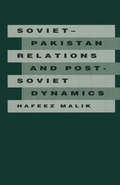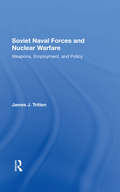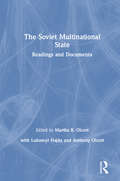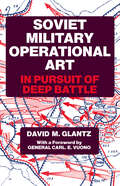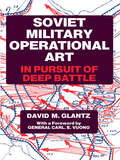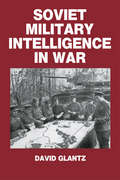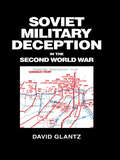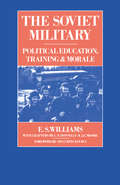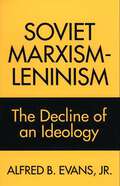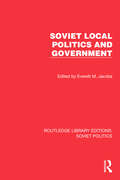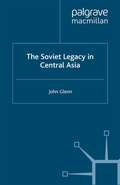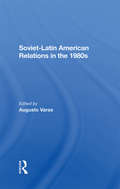- Table View
- List View
Soviet Policies in the Middle East: From World War Two to Gorbachev (PDF)
by Galia GolanThis is a comprehensive study of Soviet policies in the Middle East. Concentrating on policy developments, Professor Golan analyses the major Soviet decisions and objectives from the end of World War II to the Gorbachev era. She pays particular attention to the wars and crises of recent years and the often problematic development of political relationships in the region. Professor Golan begins by demonstrating how, until the end of the Brezhnev period, Soviet policies towards the Middle East were principally influenced by the demands of superpower competition with the USA. This is followed by a series of broadly chronological case studies of the main Soviet alliances, such as Syria and South Yemen; and of Sadat's Egypt and Khomeni's Iran. This original and important book culminates in a study of Gorbachev's interests, initiatives, and 'new thinking' in relation to overall Soviet foreign policy objectives and the role of the Soviet Union in the region.
Soviet Pol Perspect W Europe (Chatham House Papers)
by Neil MalcolmFirst Published in 1989. Routledge is an imprint of Taylor & Francis, an informa company.
Soviet Pol Perspect W Europe
by Neil MalcolmFirst Published in 1989. Routledge is an imprint of Taylor & Francis, an informa company.
Soviet Perspectives on International Relations, 1956-1967
by William ZimmermanSerious debates and discussions on world politics in Russian journals and books have greatly increased since 1956, resulting in a steadily changing appraisal of the world political situation by the Russians. Professor Zimmerman studies that changing appraisal. He describes Soviet international relations perspectives during Khrushchev's years in power and the three years following. He uncovers the answers Soviet commentators implicitly or explicitly give to such questions as: Who, in the Soviet view, are the main actors in international politics, and what does identifying them suggest about the Soviet perspective? In the Soviet analysis, what is the global distribution of power? How do Soviet analysts characterize the capabilities, motives, and decision-making process of the United States?Contents: I. Introduction. II. The Emergence of International Relations as a Discipline. III. The Actors. IV. The Hierarchy. V. The Distribution of Power. VI. United States Foreign Policy from the Soviet Perspective. VII. The Balance of Power as System and Policy. VIII. Post-Imperialism and the Transformation of Soviet Foreign Policy.Originally published in 1969.The Princeton Legacy Library uses the latest print-on-demand technology to again make available previously out-of-print books from the distinguished backlist of Princeton University Press. These editions preserve the original texts of these important books while presenting them in durable paperback and hardcover editions. The goal of the Princeton Legacy Library is to vastly increase access to the rich scholarly heritage found in the thousands of books published by Princeton University Press since its founding in 1905.
The Soviet Partisan Movement, 1941-1944: A Critical Historiographical Analysis (Soviet (Russian) Military Experience #No. 4)
by Leonid D. GrenkevichPartisans and terrorists have dominated military history during the second half of the 20th century. Leonid Grenkevich offers an account of the shadowy partisan struggle that accompanied the Soviet Union's Great Patriotic War (1941-1945).
The Soviet Partisan Movement, 1941-1944: A Critical Historiographical Analysis (Soviet (Russian) Military Experience)
by Leonid D. GrenkevichPartisans and terrorists have dominated military history during the second half of the 20th century. Leonid Grenkevich offers an account of the shadowy partisan struggle that accompanied the Soviet Union's Great Patriotic War (1941-1945).
Soviet-Pakistan Relations and Post-Soviet Dynamics, 1947–92
by Hafeez MalikThis book deserves to be read carefully by scholars and laymen of foreign policy dealing with the former Soviet Union, Russia and South Asia, and particularly by the political leaders of India and Pakistan. The book is a multi-dimensional analysis of (a) Soviet-American rivalry; (b) Soviet determination to expand in the direction of South Asia and the Gulf; (c) the regional dynamics of the Middle East most especially Iran, Afghanistan and China, the major power in Asia.
Soviet Naval Forces And Nuclear Warfare: Weapons, Employment, And Policy
by James J TrittenBased on formal content analysis of the writings of Admiral Sergei G. Gorshkov and past Soviet ministers of defense and heads of the Politburo, James J. Tritten interprets what the Soviets say they will do in the event of nuclear war. He then constructs a hardware and exercise analysis of the strategic employment of the Soviet Navy in a nuclear war, offering three possible cases–the a bolt from the blue, with existing forces on patrol; full mobilization; and a plausible case of partial mobilization. In addition, Dr. Tritten examines, from a Soviet perspective, concepts of deterrence, the strategic goals and missions of the fleet, nuclear targeting policy, the Sea Lines of Communication (SLOC) disruption mission, and the potential for tactical nuclear warfare limited to the sea. The author concludes by assessing the implications of Soviet politico-military planning for Western defense strategy and arms control.
Soviet Naval Forces And Nuclear Warfare: Weapons, Employment, And Policy
by James J TrittenBased on formal content analysis of the writings of Admiral Sergei G. Gorshkov and past Soviet ministers of defense and heads of the Politburo, James J. Tritten interprets what the Soviets say they will do in the event of nuclear war. He then constructs a hardware and exercise analysis of the strategic employment of the Soviet Navy in a nuclear war, offering three possible cases–the a bolt from the blue, with existing forces on patrol; full mobilization; and a plausible case of partial mobilization. In addition, Dr. Tritten examines, from a Soviet perspective, concepts of deterrence, the strategic goals and missions of the fleet, nuclear targeting policy, the Sea Lines of Communication (SLOC) disruption mission, and the potential for tactical nuclear warfare limited to the sea. The author concludes by assessing the implications of Soviet politico-military planning for Western defense strategy and arms control.
The Soviet Multinational State
by Martha Brill Olcott Lubomyr Hajda Anthony OlcottThe Soviet Union is a multinational state, with about half of the country's population being ethnically Russian. The advent of glasnost, and moves toward democratization and decentralization has unleashed the expression of national sentiments and interests in the USSR. This collection of Soviet materials surveys the many ramifications of the "nationality question" in the USSR in the 1980s. The topics covered include ideology, state organization, party recruitment, inter-republican economic relations, demographic factors, education, bilingualism, cultural institutions, religious traditions, military service, and disputes over republican prerogatives (in the Baltic) and over territory (the case of Nagorno-Karabakh). Each topical section includes a detailed introduction by the editor. This anthology provides coverage of the past decade, up to and including the current unrest and the impact of the Gorbachev reforms.
The Soviet Multinational State
by Martha Brill Olcott Lubomyr Hajda Anthony OlcottThe Soviet Union is a multinational state, with about half of the country's population being ethnically Russian. The advent of glasnost, and moves toward democratization and decentralization has unleashed the expression of national sentiments and interests in the USSR. This collection of Soviet materials surveys the many ramifications of the "nationality question" in the USSR in the 1980s. The topics covered include ideology, state organization, party recruitment, inter-republican economic relations, demographic factors, education, bilingualism, cultural institutions, religious traditions, military service, and disputes over republican prerogatives (in the Baltic) and over territory (the case of Nagorno-Karabakh). Each topical section includes a detailed introduction by the editor. This anthology provides coverage of the past decade, up to and including the current unrest and the impact of the Gorbachev reforms.
Soviet Military Operational Art: In Pursuit of Deep Battle (Soviet (Russian) Military Theory and Practice)
by Colonel David GlantzDavid Glantz examines the Soviet study of war, the re-emergence of the operation level and its connection with deep battle, the evolution of the Soviet theory of operations in depth before 1941, and its refinement and application in the European theatre and the Far East between 1941 and 1945.
Soviet Military Operational Art: In Pursuit of Deep Battle (Soviet (Russian) Military Theory and Practice)
by Colonel David GlantzDavid Glantz examines the Soviet study of war, the re-emergence of the operation level and its connection with deep battle, the evolution of the Soviet theory of operations in depth before 1941, and its refinement and application in the European theatre and the Far East between 1941 and 1945.
Soviet Military Intelligence in War (Soviet (Russian) Military Theory and Practice)
by Colonel David GlantzThis text is the second of three volumes written by Colonel Glantz on the contribution of intelligence and deception operations to the Soviet victory over Nazi Germany. It examines the area where intelligence and operations overlap; the nature of co-ordination between the two; and the support provided by intelligence to operational planning and execution (or the absence of such support). This is not a study of intelligence work as such, but of how intelligence can improve the chances of success on the battlefield by facilitating the more effective and economical use of troops.
Soviet Military Intelligence in War (Soviet (Russian) Military Theory and Practice)
by Colonel David GlantzThis text is the second of three volumes written by Colonel Glantz on the contribution of intelligence and deception operations to the Soviet victory over Nazi Germany. It examines the area where intelligence and operations overlap; the nature of co-ordination between the two; and the support provided by intelligence to operational planning and execution (or the absence of such support). This is not a study of intelligence work as such, but of how intelligence can improve the chances of success on the battlefield by facilitating the more effective and economical use of troops.
Soviet Military Deception in the Second World War (Soviet (Russian) Military Theory and Practice)
by David M. GlantzPublished in 1989, Soviet Military Deception in the Second World War is a valuable contribution to the field of Military & Strategic Studies.
Soviet Military Deception in the Second World War (Soviet (Russian) Military Theory and Practice #Vol. 1)
by David M. GlantzPublished in 1989, Soviet Military Deception in the Second World War is a valuable contribution to the field of Military & Strategic Studies.
The Soviet Military: Political Education, Training and Morale (RUSI Defence Studies)
by E.S. Williams C.N. Donnelly J.E. MooreSoviet Marxism-Leninism: The Decline of an Ideology
by Alfred B. EvansThis study examines the development of Marxist-Leninist ideology in the U.S.S.R. from its origins to the collapse of the Soviet regime. Alfred Evans argues that Soviet Marxism-Leninism was subject to significant adaptation under various leaders, contrary to the widespread impression that official Soviet ideology remained static after Stalin. While taking account of scholarly literature on each of the periods covered, the work is significant for being based principally on an analysis of primary (Soviet) sources. Evans' integrated analysis of changes in ideology during the post-Stalin decades is an important contribution to the literature in political science, political economy, and Soviet studies.
Soviet Local Politics and Government (Routledge Library Editions: Soviet Politics)
by Everett M. JacobsSoviet Local Politics and Government (1983) examines the local government system of the Soviet Union, an important part of the great bureaucracy that ran the country. The leading experts contributing to this book look at the wide range of duties that the local soviets managed, including supervision of the economic plan in their area, control over construction and agriculture, healthcare, housing, transport and infrastructure, and the attempts to adapt the local government system to new circumstances and requirements.
Soviet Local Politics and Government (Routledge Library Editions: Soviet Politics)
by Everett M. JacobsSoviet Local Politics and Government (1983) examines the local government system of the Soviet Union, an important part of the great bureaucracy that ran the country. The leading experts contributing to this book look at the wide range of duties that the local soviets managed, including supervision of the economic plan in their area, control over construction and agriculture, healthcare, housing, transport and infrastructure, and the attempts to adapt the local government system to new circumstances and requirements.
The Soviet Legacy in Central Asia
by J. GlennThis book analyses the new pattern of security concerns of the Central Asian successor states. This region is said to encompass Kazakhstan, Uzbekistan, Tadzhikistan, Kirghizstan and Turkmenistan. The main contention of the book is that the security problems of these states are similar to those that faced other 'Third World' countries after they attained independence. That is, due to the arbitrary creation of these states by external powers they lack a certain degree of societal cohesiveness arising from the fact that several ethnic communities reside within their borders. It is this so-called 'insecurity dilemma' of each of the Central Asian states that is therefore examined.
Soviet-Latin American Relations In The 1980s
by Augusto VarasSoviet involvement in Latin America has been defined by U.S. policymakers as disruptive of the regional political and security order, and U.S. policy has been formulated to prevent the escalation of Soviet presence in the region. In this volume, Latin American scholars provide case studies of the economic, political, and military influence of the S
